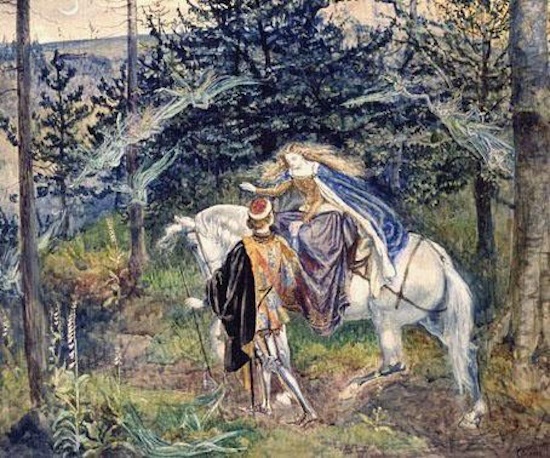
La Belle Dame Sans Merci. 1865. Oil on canvas. 19 x 23 inches (48 x 58 cm). Private collection. Image courtesy of Sotheby's, London. [Click on images to enlarge them.]
This early painting from 1865 does not appear to have been exhibited in any of the usual London venues. The subject is based on John Keats's famous poem, "La Belle Dame sans Merci," of 1819 about a beautiful sorceress who would enchant men and lure them to their deaths — particularly the following stanzas:
I met a lady in the meads,
Full beautiful - a faery's child,
Her hair was long, her foot was light,
And her eyes were wild.
I made a garland for her head,
And bracelets too, and fragrant zone;
She looked at me as she did love,
And made sweet moan.
I set her on my pacing steed,
And nothing else saw all day long,
For sidelong would she bend, and sing
In Crane's picture we see a knight clad in armour, covered by a mantel with heraldic designs, walking on a path in the woods. He is clasping the left hand of the beautiful youthful enchantress that he has mounted side-saddle on his "prancing steed." She is clad in a gold and purple gown with a blue cloak edged with ermine. She wears white flowers in her long free-flowing hair. In Pre-Raphaelite paintings loose, luxuriant hair is frequently considered an emblem of female sexuality as well as symbolic of the femme fatale (De Girolami Cheney 160). The knight is so enamoured with her that he is oblivious of his danger.

La Belle Dame Sans Merci. 1865. Watercolour on paper. 17 1/2 x 21 5/8 inches (44.5 x 55 cm). Private collection. Courtesy of Peter and Renate Nahum.
Crane painted a watercolour version of this same subject, also in 1865, with the addition of ghostly apparitions. Much later he used his initial La Belle Dame Sans Mercy design as the source of an illustration used as the tailpiece for The Faerie Queene by Edmund Spenser, published by George Allen. It illustrated Book VI, Canto III, p. 1338 in the 1896 edition. Much later still, he produced a version of La Belle Dame Sans Merci showing the knight on horseback gazing at the beautiful lady standing on the ground and looking back at him. He exhibited this painting at the Institute of Painters in Oil in 1884.
Keats's "La Belle Dame Sans Merci" was a popular subject with Victorian and Edwardian painters, especially those associated with the Pre-Raphaelite circle. As early as the mid-1850s D. G. Rossetti and Elizabeth Siddal both did pencil sketches of this subject. Arthur Hughes did an oil painting of 1863 similar in composition to Crane's version. It was rejected by the Royal Academy but was shown at the Cosmopolitan Club in May 1863. William Bell Scott designed a wood-engraved frontispiece for The Poetical Works of John Keats published by Routledge in 1873. Later in the nineteenth century one finds versions by artists such as John William Waterhouse, Frank Dicksee, and Henry Meynell Rheam. As late as 1926 Frank Cadogan Cowper painted his version of the subject. Dicksee's rendition is the one closest to Crane's much earlier picture.
Related Material
- Four Keats Poems and the Pre-Raphaelite Vision of the Middle Ages
- The Devouring Woman and Her Serpentine Hair in Late-Pre-Raphaelitism
- The Oxford Handbook of Victorian Medievalism [Review]
- Victorian Fairy painting
Bibliography
Crane, Walter. An Artist's Reminiscences. London: Methuen & Co., 1907, 71 & 244.
De Girolami Cheney, Liana: "Locks, Tresses and Manes in Pre-Raphaelite Paintings." Pre-Raphaelitism and Medievalism in the Arts. Dyfed, Wales: Edwin Mellen Press, 1992. 159-173.
Scott, Grant F. "Language Strange: A Visual History of Keat's 'La Belle Dame sans Merci.'" Studies in Romanticism XXXVIII (Winter 1999): 503-35.
Spencer, Isobel. Walter Crane. New York: Macmillan Publishing Co. Inc., 1975.
Valuable Books and Manuscripts. London: Christie's (July 12, 2023): lot 95. https://www.christies.com/en/lot/lot-6437972
Victorian & Edwardian Art. London: Sotheby's (May 17, 2011): lot 23. https://www.sothebys.com/en/auctions/ecatalogue/2011/victorian-edwardian-art-l11132/lot.23.html
Created 16 November 2025